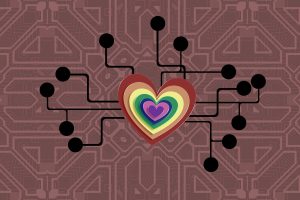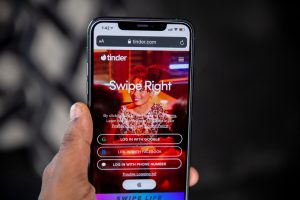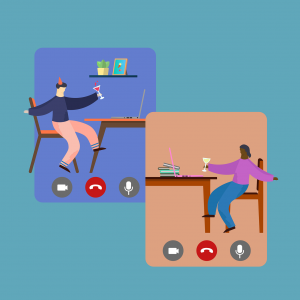34 Online Dating Apps
Matt Fry
34.1 Introduction
Keywords
- Online dating – a system that enables people to introduce themselves to potential connections over the internet
- Matchmaking algorithm – a code that gives users potential matches that would be optimal for the user based on their personality and in-app tendencies
- Generation Z – generation that was born between 1997-2012 that has been raised on the internet and social media
- Digital Age – time period when computers and personal technology were introduced to provide users with access to easily and quickly transfer information
- Uses and Gratifications Theory – the understanding of why and how people seek out specific media to satisfy specific needs
Learning Objectives
By the end of this chapter, students should be able to:
- Define online dating
- Identify when and why online dating technology became prominent in society
- Understand why people use online dating and the motivational factors affiliated with it
- Understand how online dating is a form of communication
- Differentiate between the pros and cons of of online dating
- Describe where the online dating industry is heading based on trends and real world circumstances
- Understand the mental consequences of using online dating
From a general point of view, one could conclude that the overwhelming majority of college students have some form of social media. If you were to ask a college student, what would be the primary mode of communication if you were not face to face with the other person? The overwhelming majority would probably say a social media app such as Instagram, Snapchat, Twitter, or even Tinder.
As many current college students have battled through Covid-19 and the impacts it had on society (isolation and quarantine), online dating apps became have become a great way to communicate with new people and have generated some sense of normalcy by using it as a way to interact with others. However, online dating is proven not to be for everyone. Online dating may not fit every person’s preferred communication styles, but it is undisputed that they provide convenient communication, whether it be genuine or not. Online dating has shown to be a convenient and casual way for individuals to mingle, however relying on online dating can be more detrimental to an individual’s personality and mental health. In this chapter, we will discuss the origins of online dating, the motivating factors people have to use the apps, pros and cons of online dating, and what online dating could look like in the future.
34.2 What is Online Dating
Key Takeaway
Online dating is a unique concept that looks at dating outside of the traditional realm a lot of students and parents grow up in. Online dating can be defined as a technology that allows people to find, connect, and introduce themselves to others over the Internet. The technology is developed with the goal for people to build personal, romantic, or sexual relationships with partners who have similar interests. What a lot of users are looking for is a personalized experience, something that can easily give users exactly what they are looking for quickly after downloading the app with the goal to get people to continue to use the app.
34.2.1 Types of Technology in Dating Apps
There are a lot of different technologies that go into creating a dating app and giving users the experience they desire. The biggest technology that is emphasized is the matchmaking algorithm. Matchmaking algorithm takes the users preferences based on data they input into the app and aligns them with people who have similar interests and preferences. The technology mainly behind the algorithm is artificial intelligence (A.I.). A.I. uses predictive analytics to rank potential matches for a user based on tendencies the user has indicated through their previous swipes and information they have put in their bios (Bansal, 2020). Additionally, dating apps have begun to use geographic location technology to match users based on proximity because it is more likely people will connect if they feel they can easily meet face to face. Another piece of technology used is non-text chat options. These include the ability for users to send videos, pictures, GIFs, voice messages, and video chat. At this point the dating app company has done all it can to enhance the user’s experience; it is now up to the user to determine whether they want to pursue a relationship by swiping a certain direction in the app or possibly messaging the individual.
34.2.2 Relationship to Communication and Social Media
When one thinks of social media platforms, online dating apps usually don’t come to mind. Online dating apps are a tool for people to meet and message each other, similar to traditional social media apps such as Snapchat. Tinder, for example, contains swiping to match with a particular person then messaging each other like a normal start-up conversation. Each individual has a bio where they fill out their passions or anything they want others to know about themselves; it is like giving off a first impression. Additionally, as it pertains to communication, online dating apps are a prime example of two individuals meeting for the first time and communicating their interests and values to one another. A lot of the time, people will put their other social media handles in their online dating bio and use that as another way to communicate with others. Thus, Tinder, Bumble, and other online dating websites should be categorized and thought of as social media apps because they serve the same purpose as traditional social media apps.

“Heart Online Dating Appointment Get To Know Meeting” by Max Pixel is in the Public Domain, CC0
34.3 History of Online Dating
Key Takeaway
Online dating apps became prominent in society recently and thrive during times of isolation and separation. People use online dating for many different reasons, mainly stemming back to one’s personality.
Online dating and the implementation of online dating apps are a relatively recent technological innovation. The first online dating websites were kiss.com and match.com which were founded in 1994 and 1995. By 1996, there were 16 dating websites. Generation Z can be linked to the start up of online dating (due to the time)because of when they were born, and also the fact that they have grown up in the Digital Age. The Digital Age is a period when the development of new technology is focused on electronic devices such as computers and cell phones. This is significant because the people using online dating were born during this age and technology is all they know because they have had it their entire lives growing up.
34.3.1 Why Online Dating Took Off
Online dating apps took off for two main reasons: a comfortable, convenient way for people to meet new people who do not necessarily have the ability to meet people face to face and situational circumstances around the world. To emphasize how quickly online dating took off, in 2007, about ten years after the first website was created, Americans spent over $500 million on online dating, making it the second highest industry for “paid content” on the Web” (Ali & Wibowo, 2011, p. 483). As a result, it is proven that technology plays a major role in relationship building and the economy of online dating.
First, once smartphones became popular, users quickly figured out how to use them to start relationships. Through innovation and people’s increased reliance on smartphones for everyday activities, there became a need for a way for people to meet over the phone. Thus, online dating apps surged.
Secondly, isolation from the quarantine of COVID-19 also forced people to be alone and rely on their phones for regular life. Apps such as Tinder and Bumble took off mainly because Gen Z felt the need to return to normalcy quickly and resume going outside to meet people. Because of this, individuals relied on dating apps as a way to talk to new people and spice up their own lives in a time of uncertainty and isolation. As a result, it is proven that technology plays a major role in relationship building and the economy of online dating.
34.3.2 Motivations and Reasons for Using Online Dating
Every person has a different personality and because of that dating comes easier for some and harder for others. Individuals use online dating for a variety of reasons and one’s personality as well as situational factors outside one’s control can play a part in what motivates individuals to pursue online dating. The motivations behind individuals using online dating can be linked to Uses and Gratifications Theory. This theory outlines three gratification motives people generally have in their lives: physical, social, and psychosocial. Physical is the need for physical love and attention. Social is the need to find new partners and friendships. Psychosocial refers to the needs that have psychological origin but interact with social variables (Sumter et al., 2017). These three needs are the driving force behind why individuals feel the need to use online dating. Additionally, outside factors such as the COVID-19 pandemic increase motivation to use online dating apps. It was found that when individuals are faced with a threat to their basic needs, as outlined previously, there is motivated behavior to reduce distress. The pandemic is a prime example of individuals using online dating to fulfill their ordinary needs, such as the need for belonging, safety, and esteem, that were threatened by the shutdown of normal life. The need for solace can also be attributed to an increase in online dating as a result of the pandemic. Thus, it is shown that basic personal needs and the threat of losing those needs by an outside source are some of the reasons online dating has seen a drastic uptick in the number of users on online dating platforms.

“Mobile Shopping Trade Connection” by kalhh is under a Pixabay License
34.4 Impact of Online Dating on Society
Key Takeaway
Online dating is a subjective topic for people with the concept fitting many people’s personalities and lifestyles but also not fitting other’s ideal dating method. Online dating has many pros and cons and based on research, the significance of the cons outweigh the pros because they are more detrimental to an individual’s character. Many of the benefits of using online dating apps revolve around the freshness of relationships and convenience for the user, while many of the drawbacks are centered around rejection, the users mindset and the psychological aspect of one’s character.
34.4.1 Pros of the Online Dating
As previously described, online dating technology took over the Internet as a result of the pandemic specifically for individuals 18-30 years of age because of their need for normalcy in uncertain times. The purpose of this technology is to simplify the dating process and make it more convenient for individuals who struggle with traditional dating.
As it pertains to communication within online dating, using online dating apps enable safer and more convenient communication with much less risk and time commitment. For individuals with busy work schedules or people who have trouble opening up about themselves could benefit from online dating because they control when they date. These individuals can communicate with partners on their own time and schedule. Additionally, for safety conscious users, this form of communication is a great way to test for potential partners because users can reveal as much or as little information at their own disposal. Also, there is little risk involved because the user can stop communicating and unmatch with the other person when they feel uncomfortable.
Another benefit to the technology pertains to the matchmaking algorithms. The goal of these algorithms is to expose individuals to a lot of similar individuals in a short amount of time. Online dating is great because users can access many more potential partners with the click of a button or swipe of a finger than they could often meet in their daily lives. This also helps with individuals with busy professional schedules because they’d be able to communicate with dozens of new people every day rather than the same people at work. Furthermore, individuals who are looking for a specific type of person, lifestyle, or orientation in a particular area could benefit from the ability to swipe quickly because the algorithms match people with similar interests almost instantaneously. Thus, the main benefits of online dating revolve around convenience and the ability to date based on one’s own schedule while maximizing potential compatible matches.

“Tinder Home Page Online Dating” by solenfeyissa is under a Pixabay License
34.4.2 Cons of Online Dating
While the benefits of convenience are indisputable, quick-starting relationships online can be labeled as unnatural and may not carry a lot of significant meaning. The communication between apps and computers may be lacking some of the information provided in face to face interactions such as emotion. In face to face interactions, non verbal communication gestures can go a long way in bonding with an individual. For example, smiling, nodding, or using hands to emphasize points made in a conversation can increase the genuineness as they are signals to the partner that indicate interest in the subject and person. In other words, individuals can say certain things over a phone to appeal to their partner without any emotional significance resulting in potentially leading the partner on when there may not be a connection; it is much easier to hide behind a phone, while it might minimize risk, this communication could also be deceptive to partners.
Because online dating is over the phone, there is an absence of some cues and features from face to face interactions that build physical attraction. For example, subtle physical contact and touching cannot be present in the start-up of an online relationship, both of which could be a major characteristic some people want in a relationship. Physical contact also relates to displaying emotion towards a partner because emotion tends to lead to physical contact, but in an online relationship, both could be non-existent.
Additionally, adverse events and unwanted sexual messages from partners are negatives to online dating. Deception can play a part in adverse events because of how a person could present themselves over the phone. When individuals engage in online dating then meet in person, some of the times people could present a different personality over the phone than when the two actually meet. This could cause one individual to become uncomfortable because they are expecting to meet one type of person, but actually it is a completely different person. Thus, the cons of unnatural, emotionless communication, genuineness, lack of physical appeal, and deceptiveness leading to uncomfortable interactions can have more of an impact on individuals than the convenience and increased opportunity to build a relationship.
Case Study: Adapt to Surroundings!
It is the summer of 2020 and America is in peak COVID-19 quarantine time. Jim is an employee at a large firm and the company made the decision to send its employees home to work remotely to protect them from the pandemic. This hurt Jim because he is a social guy who enjoys meeting new people and was actively looking to pursue a relationship. Jim’s need for social interaction took a hit and had to turn to an alternative way to meet people. He turned to online dating.
Jim was able to match with a lot of new people at his own discretion and enjoyed the adrenaline of stepping outside of his comfort zone and moving to meeting people online. It was super convenient for him, however he felt a lot of the relationships he was making were not genuine and full of legitimate emotion. The pain of constant rejection was creeping into his head and his confidence was a bit lower than usual. On the contrary, there were a few connections that stood out to Jim and he was able to get to know those people on a more personal level than many of his other matches. Video chat features helped immensely with Jim taking that next step with certain people. Overall, it was a good experience for Jim as he was able to fulfill some of his social needs during isolation. However, now that public places are starting to open back up and Jim is returning to his normal, interactive life, meeting new people wherever he goes, he is relying on face to face interactions as they seem to have a more genuine vibe.
34.5 Effects and Future Outlook
Key Takeaway
An additional part of online dating involves the effects it can have on a person’s mental health. It is hard to generate a significant, successful relationship online. People are going to fail and experience rejection, however everyone deals with rejection differently and that can take a toll on people mentally. Rejection is extremely common in the online dating world, in fact, according to a series of surveys, “50% of online matches do not return messages” (Constantin, 2020, para. 3). When messages are not returned, it can be inferred that the user is disliked or not cared for which can cause mental pain. Additionally, the mental pain associated with rejection is not much different than physical pain. The parts of the brain that get activated from physical pain are the same parts that are activated when people are faced with rejection. This is significant because while people remember physical pain, it will go away and the individual will likely not experience the same thing again. However, the pain of rejection can constantly be remembered when any situation that is similar occurs and this will lead to remembering the pain immensely.
Online dating apps can also affect people mentally because they could lower an individual’s self-esteem. Regular and constant rejection plays a part in the lowering of self-esteem because online dating allows for people to meet a lot of new people quickly. An individual could quickly feel compatible with their potential partner, however those feelings may not be completely reciprocated which can lead to lowered confidence and ultimately rejection. Furthermore, if one partner constantly tries to generate reciprocated feelings from the other, that can also lead to lowered self-esteem because the user could think something is wrong with themselves, ultimately resulting in constant rejection.
34.5.1 Future of Online Dating
Online dating thrived as a result of the COVID-19 pandemic. People were stuck in their house and relied on their phones and dating apps to meet new people. In-person dates became non-existent as restaurants and bars were closed as a result of the pandemic. People turned to social media to interact with others and the dating platforms have expanded accordingly to accommodate the uptick in usage. For example, many dating platforms are introducing video chat features which is how online dating is becoming more personable. Zoom and video dates have become increasingly popular during and after the pandemic, both of which are technological innovations that can continue to develop for the future of online dating. According to some studies, one in three couples who get married are reported to have met online and that number might be closer to one in two after the pandemic (Kibbe, 2021). Thus, with the addition of video chatting and increased popularity amongst online dating, the future of the technology seems to be becoming more personable and similar to face to face interaction because of the emphasis of video features.

“Video Chat Online Celebration Video Call Drink” by MaxPixel is in the Public Domain, CC0
Chapter Summary
Online dating is a way for people to connect with potential matches at the swipe of a finger based on lifestyle preferences, personality, and geographic location. In other words, online dating can be described as a form of social media due to the ability to communicate with anyone essentially anywhere. The pandemic gave liftoff to the concept of online dating because of the isolation people faced. People have needs and when there is an event blocking the fulfillment of those needs, people naturally turn to alternatives; in this case the alternative was online dating. It fits people’s needs because it was convenient and people could communicate with others from home and on their own time. However, many online relationships can be labeled as unnatural, deceptive, and could make individuals uncomfortable because the personality presented online could be completely different when meeting face to face. Additionally, constant rejection from partners could take a toll on an individual and cause mental health issues such as lower self-esteem and confidence. To help resolve that problem, online dating platforms are becoming more personable by adding features such as video chat that aims to make online dating closer to face to face interactions.
Review Questions
1. _________________ is the main technology used in online dating apps to pair individuals together based on personality and geographic similarities.
A. Matchmaking algorithm
B. Identification Tech
C. Personality test
D. Coincidental algorithm
2. What world event can be linked to the sudden uptick of online dating activity?
A. Global warming
B. The reopening of public places
C. COVID-19 Pandemic
D. Presidential election
3. What are the three motives explained in the Uses and Gratifications Theory that correspond to starting relationships?
A. Social, psychological, emotional
B. Physical, social, self-esteem
C. Physical, social, psychological
D. Psychological, physical, interactive
4. What concept is the main reason individuals lose confidence in themselves and experience mental pain as a result of online dating?
A. Rejection
B. Affirmation
C. Power struggle
D. Fatigue
Answers:
- A
- C
- C
- A
Food For Thought
- Reflect on the pros and cons described in the chapter. Do you think the cons outweigh the pros or do you think there is more benefit to using online dating than what the drawbacks suggest?
- Make a prediction about the future of online dating. In addition to video chat that is being implemented to platforms, what is another pre-existing technology or new technology that you think would benefit the online dating industry?
References
Ali, A. I., & Wibowo, K. (2011). Online dating services–chronology and key features comparison with traditional dating. Competition Forum, 9(2), 481-488.
Bansal, A. (2020, April 8). When love met technology: How software solutions have enhanced the matching and dating industry. Forbes. https://www.forbes.com/sites/forbestechcouncil/2020/04/08/when-love-met-technology-how-software-solutions-have-enhanced-the-matching-and-dating-industry/?sh=789862e247f6.
Constantin, G. (2020, July 22). Online dating and its effects on Mental Health. Thrive Global. https://thriveglobal.com/stories/online-dating-and-its-effects-on-mental-health/.
Joshi, G., Rais, S., Ann, M., & Mishra, I. (2020). Online dating: A motivated behavior during pandemic. Indian Journal of Health, Sexuality & Culture, 6(2), 22-32. 10.5281/zenodo.4295667
Kibbe, K. (2021, March 18). What will dating apps be like after the pandemic? InsideHook. https://www.insidehook.com/article/sex-and-dating/post-covid-future-online-dating.
Nicholson, J. (2014, April 30). Pros and cons of online dating. Psychology Today. https://www.psychologytoday.com/us/blog/the-attraction-doctor/201404/pros-and-cons-online-dating.
Sumter, S. R., Vandenbosch, L., & Ligtenberg, L. (2017). Love me Tinder: Untangling emerging adults’ motivations for using the dating application Tinder. Telematics and Informatics, 34(1), 67–78. https://doi.org/10.1016/j.tele.2016.04.009
Timmermans, E., & De Caluwé, E. (2017). To Tinder or not to Tinder, that’s the question: An individual differences perspective to Tinder use and motives. Personality and Individual Differences, 110(1), 74–79. https://doi.org/10.1016/j.paid.2017.01.026
Vandeweerd, C., Myers, J., Coulter, M., Yalcin, A., & Corvin, J. (2016). Positives and negatives of online dating according to women 50. Journal of Women & Aging, 28(3), 259–270. https://doi.org/10.1080/08952841.2015.1137435
A system that enables people to introduce themselves to potential connections over the internet.
A code that gives users potential matches that would be optimal for the user based on their personality and in-app tendencies.
Generation that was born between 1997-2012 that has been raised on the internet and social media.
Time period when computers and personal technology were introduced to provide users with access to easily and quickly transfer information.
The understanding of why and how people seek out specific media to satisfy specific needs.

